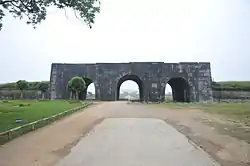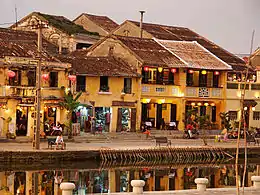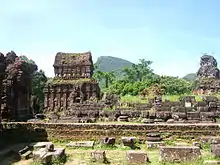List of World Heritage Sites in Vietnam
The UNESCO (United Nations Educational, Scientific and Cultural Organization) has designated eight World Heritage Sites in Vietnam.[1] The UNESCO World Heritage Sites are places of importance to cultural or natural heritage as described in the UNESCO World Heritage Convention.

World Heritage Sites
UNESCO lists sites under ten criteria; each entry must meet at least one of the criteria. Criteria i through vi are cultural, whereas vii through x are natural.[2]
| Site | Image | Location (municipality) | Year listed | UNESCO data | Description | Ref. |
|---|---|---|---|---|---|---|
| Central Sector of Imperial Citadel of Thăng Long |  |
Hà Nội | 2010 | 1328; (ii), (iii), (vi) (cultural) | The royal enclosure was first built during the Lý dynasty (1010) and subsequently expanded by the Trần, Lê and finally the Nguyễn dynasty. It remained the seat of the Vietnamese court until 1810, when the Nguyễn dynasty chose to move the capital to Huế. The ruins roughly coincide with the Hanoi Citadel today. | |
| Citadel of the Hồ Dynasty |  |
Thanh Hóa | 2011 | 1358; (ii), (iv) (cultural) | Also called Tây Đô castle or Tây Giai castle) is a citadel in Vietnam, constructed by the Hồ Dynasty (1400-1407) . | [3] |
| Complex of Huế Monuments | .jpg.webp) |
Huế | 1993 | 678; (iv) (cultural) | The Imperial City (Vietnamese: Hoàng thành) is a walled enclosure within the citadel (Kinh thành) of the city of Huế, the former imperial capital of Vietnam. | |
| Hạ Long Bay |  |
Quảng Ninh | 1994 | 672; (vii), (viii) (natural) | The bay features thousands of limestone karsts and isles in various shapes and sizes. Ha Long Bay is a center of a larger zone which includes Bai Tu Long Bay to the northeast, and Cat Ba Island to the southwest. These larger zones share a similar geological, geographical, geomorphological, climate, and cultural characters. | |
| Hội An Ancient Town |  |
Quảng Nam | 1999 | 948; (ii), (v) (cultural) | Old Town Hội An, the city's historic district, is recognized as an exceptionally well-preserved example of a Southeast Asian trading port dating from the 15th to the 19th century, its buildings and street plan reflecting a blend of indigenous and foreign influences. | |
| Mỹ Sơn Sanctuary |  |
Quảng Nam | 1999 | 949; (ii), (iii) (cultural) | Mỹ Sơn is a cluster of abandoned and partially ruined Hindu temples in Vietnam, constructed between the 4th and the 14th century AD by the kings of Champa (Chiêm Thành in Vietnamese). The temples are dedicated to the worship of the god Shiva, known under various local names, the most important of which is Bhadreshvara. | |
| Phong Nha – Kẻ Bàng National Park |  |
Quảng Bình | 2003 | 951; (viii), (ix), (x) (natural) | Phong Nha-Kẻ Bàng is noted for its cave and grotto systems as it is composed of 300 caves and grottos. A 2009 survey brought the total discovered length of the cave system to about 126 km with many areas still not well explored. | |
| Tràng An Landscape Complex | .jpg.webp) |
Ninh Bình | 2016 | 1438; (v), (vii), (viii) (mixed) | Tràng An is a scenic area near Ninh Bình, Vietnam renowned for its boat cave tours. In the Trang An landscape complex, the center of Hoa Lu ancient capital in the north, Tam Coc - Bich Dong tourist area is in the south and Trang An eco-tourism area is in the central position. These three areas are linked together by Hoa Lu special-use forest on limestone mountains and rivers, lakes and swamps. |
Tentative list
In addition to the sites inscribed on the World Heritage List, member states can maintain a list of tentative sites that they may consider for nomination. Nominations for the World Heritage List are only accepted if the site was previously listed on the tentative list.[4] As of 2019, Vietnam recorded seven sites on its tentative list.
| Site | Image | Location (municipality) | Year listed | UNESCO data | Description | Ref. |
|---|---|---|---|---|---|---|
| The Area of Old Carved Stone in Sapa |  |
Lào Cai | 1997 | 959; (cultural) | The site is home to more than 200 old carved stones and megaliths, mainly in Muong Hoa valley. | [5] |
| Ba Bể – Na Hang Natural Heritage Area |  |
Tuyên Quang and Bắc Kạn | 2017 | 6262; (vii), (x) (natural) | The site includes Ba Be National Park, Nam Xuan Lac Nature Reserve, Na Hang Nature Reserve, and Lam Binh Protection Forest. | [6] |
| Cát Tiên National Park |  |
Đồng Nai | 2006 | 5070; (vii), (ix), (x) (natural) | A UNESCO Biosphere Reserve and important wet tropical forest. | [7] |
| The Complex of Yên Tử Monuments and Landscape |  |
Quảng Ninh and Bắc Giang | 2014 | 5940; (ii), (iii), (v), (vi), (vii) (mixed) | The anscestral land of Truc Lam Zen Buddhism in Vietnam. It encompasses Yen Tu, Dong Trieu, and West Yen Tu. | [8] |
| Con Moong Cave | .jpg.webp) |
Thanh Hóa | 2006 | 5072; (mixed) | The site, located within the Cúc Phương National Park, is the central importance for the study of the Mesolithic Hoabinhian culture. | [9] |
| Hạ Long Bay – Cát Bà Archipelago |  |
Quảng Ninh and Hải Phòng | 2017 | 6177; (vii), (viii), (ix), (x) (natural) | The Cat Ba archipelago is being proposed as an extension to current Ha Long Bay UNESCO site. | [10] |
| Hương Sơn Complex of Natural Beauty and Historical Monuments |  |
Hà Nội | 1991 | 960; (mixed) | The site is an important ecological zone and cultural zone, with archaeological sites dating back 10,000 years and geologic formations dating back 200 million years. | [11] |
See also
- Protected areas of Vietnam
- List of national parks of Vietnam
- List of World Heritage Sites in Southeast Asia
- List of Memory of the World Registers in Asia and the Pacific
- List of Intangible Cultural Heritage
- List of World Network of Biosphere Reserves in Asia and the Pacific
- List of members of the Global Geoparks Network
- List of ASEAN Heritage Parks
- List of Ramsar wetlands of international importance
References
- "World Heritage Properties in Vietnam". UNESCO. Retrieved 28 January 2019.
- "UNESCO World Heritage Centre – The Criteria for Selection". UNESCO World Heritage Centre. Archived from the original on 12 June 2016. Retrieved 17 August 2018.
- "Citadel of the Ho Dynasty". UNESCO World Heritage Centre. United Nations. Retrieved 15 June 2019.
- "UNESCO World Heritage Centre – Tentative Lists". UNESCO World Heritage Centre. Archived from the original on 20 July 2017. Retrieved 25 October 2015.
- https://whc.unesco.org/en/tentativelists/959/
- https://whc.unesco.org/en/tentativelists/6262/
- https://whc.unesco.org/en/tentativelists/5070/
- https://whc.unesco.org/en/tentativelists/5940/
- https://whc.unesco.org/en/tentativelists/5072/
- https://whc.unesco.org/en/tentativelists/6177/
- https://whc.unesco.org/en/tentativelists/960/


